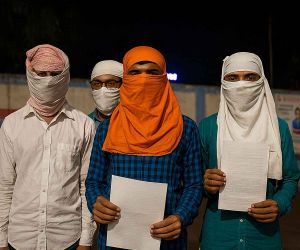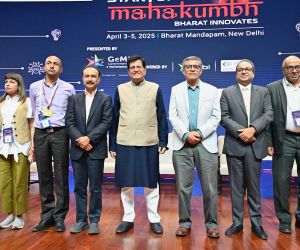MORE COVERAGE
Twitter Coverage
Satyaagrah
Written on
Satyaagrah
Written on
Satyaagrah
Written on
Satyaagrah
Written on
Satyaagrah
Written on
JOIN SATYAAGRAH SOCIAL MEDIA
"Reach high, for stars lie hidden in your soul": Marking an historic feat, ISRO successfully launched 7 Singaporean satellites, each showcasing technological prowess, another milestone of India-Singapore partnership and the future of space exploration

In a momentous event that further deepens the ties between India and Singapore, the Indian Space Research Organisation (ISRO) successfully launched seven Singaporean satellites from Sriharikota, a barrier island off the Bay of Bengal coast located in the Indian state of Andhra Pradesh. The historic launch took place from the First Launch Pad (FLP) at the Satish Dhawan Space Centre (SDSC), Sriharikota, adding another glorious chapter to the space partnership between the two nations.
|
The Indian High Commission in Singapore expressed its pride and delight at this landmark achievement on Sunday, describing the successful launch as another milestone in the India-Singapore space partnership. The Commission shared its enthusiasm through a tweet, which read, "India-Singapore space partnership marks another milestone with the launch of 7 Singaporean satellites by Indian space agency ISRO today."
At the dawn of Sunday, the ISRO commenced the launch of the PSLV-C56 rocket, carrying seven satellites, including the principal satellite DS-SAR and six auxiliary passenger satellites. The launch pad, situated at the Satish Dhawan Space Centre (SDSC) SHAR, Sriharikota, witnessed the rocket's magnificent take-off at precisely 6.30 am.
ISRO commemorated the achievement on their Twitter handle, expressing gratitude to NSIL_India and Singapore for the collaborative effort. They tweeted, "PSLV-C56/ DS-SAR Mission: The mission is successfully accomplished. PSLV-C56 vehicle launched all seven satellites precisely into their intended orbits. Thanks to @NSIL_India and Singapore, for the contract."
This launch holds notable significance as it represents the 58th overall PSLV flight and the 17th employing the Core Alone configuration. Following the injection of all the satellites, the upper stage of the rocket was deliberately positioned in a lower orbit to ensure a shorter orbital lifespan, as per ISRO's release.
The mission, known as PSLV-C56 / DS-SAR, was the Dedicated Commercial Mission of NewSpace India Limited (NSIL) for ST Engineering, Singapore. DS-SAR, a Radar Imaging Earth Observation satellite, was the mission's primary satellite. In addition to DS-SAR, six other co-passenger customer satellites were also part of this mission, all of which belong to Singapore.
|
The DS-SAR satellite, along with its six co-passenger satellites, were injected into a circular orbit 535 km above the Earth's surface, at an orbital inclination of 5 degrees. This strategic positioning would allow the satellites to execute their respective functions effectively.
DS-SAR is a product of a cooperative effort between DSTA (representing the Government of Singapore) and ST Engineering. The Singaporean Government will use the operational DS-SAR satellite to fulfill the satellite imagery requirements of various governmental agencies. Concurrently, ST Engineering plans to utilize it to provide multi-modal and high-responsive imagery and geospatial services to its commercial clientele.
Furthermore, DS-SAR is equipped with a Synthetic Aperture Radar (SAR) payload, an advanced technology developed by Israel Aerospace Industries (IAI). This state-of-the-art feature enables the DS-SAR satellite to offer all-weather day and night coverage, and it is capable of capturing images at an incredible 1m resolution with full polarimetry.
Accompanying the primary satellite, DS-SAR, the launch also involved the VELOX-AM, a 23 kg technology demonstration microsatellite, ARCADE Atmospheric Coupling and Dynamics Explorer (ARCADE), an experimental satellite, SCOOB-II, a 3U nanosatellite flying a technology demonstrator payload, NuLIoN by NuSpace, an advanced 3U nanosatellite enabling seamless IoT connectivity in both urban & remote locations, Galassia-2, a 3U nanosatellite destined to orbit at low earth orbit, and ORB-12 STRIDER, a satellite developed under international collaboration.
To sum up, this launch illustrates the strengthening of bonds between India and Singapore, reinforcing their partnership in space exploration and technology. The event marks a significant stride in the field of space research, underscoring the expertise and capabilities of the ISRO and fostering a sense of national pride.
|
Payload
Let's delve into the specifics of the payload carried by the ISRO rocket that recently marked another successful chapter in the India-Singapore space partnership. The rocket carried several noteworthy satellites, including SCOOB-II, NuLIoN, Galassia-2, and ORB-12 STRIDER, each of which serves distinct functions and offers unique contributions to the field of space exploration.
Starting with SCOOB-II, this satellite stands as a testament to student ingenuity and innovation. The Satellite Research Centre (SaRC) at Nanyang Technological University (NTU) in Singapore took up the task of designing and developing this satellite, which falls under the category of a 3U CubeSat. An integral part of the mission, the SCOOB-II satellite, is expected to fulfill its role in the six-month-long mission.
What makes SCOOB-II unique is its sophisticated attitude control system. For this, it employs a three-axis controlled reaction wheel assembly, a state-of-the-art system that allows for precise navigation and positioning in the vast expanse of outer space.
Moving on to NuLIoN, this 3U nanosatellite is the brainchild of NuSpace, a leading name in space technology. NuLIoN stands as the pioneer satellite for a Low Earth Orbit (LEO) equatorial constellation. This satellite constellation is designed to offer continuous LoRaWAN IoT services, thus further strengthening and expanding the realm of global connectivity.
The third notable payload is Galassia-2, an educational 3U nanosatellite conceived and developed by the National University of Singapore (NUS). Galassia-2's primary mission is of particular interest: it is designed to create an inter-satellite link (ISL) with TeLEOS-1. Galassia-2 is set to demonstrate the impressive potential of using Commercial Off The Shelf (COTS) multispectral imagery for space applications, an achievement that could revolutionize space technology.
The final satellite, ORB-12 STRIDER, represents an inspiring story of international collaboration. This project was coordinated by Singapore-based ALIENA and brought together the expertise of Orbital Astronautics as bus providers and Aurora Propulsion Technologies as subsystem co-developers.
ORB-12 STRIDER is designed to showcase the power and capabilities of the next-generation propulsion systems. These systems are specifically catered to the requirements of small satellite constellations, a burgeoning area in space research and exploration. The innovative nature of this satellite doesn't end there. The ORB-12 STRIDER is equipped with the world's first Multi-modal all-Electric Propulsion Engine (MEPE). This cutting-edge technology incorporates ALIENA's flagship Multi-Stage Ignition Compact (MUSIC) Hall thruster and Aurora's ARM resistojets, both of which represent the pinnacle of propulsion system design.
In essence, each of these satellites, SCOOB-II, NuLIoN, Galassia-2, and ORB-12 STRIDER, are marvels of modern space technology. They are designed with precise objectives and equipped with advanced systems, promising to contribute significantly to the ongoing advancements in space exploration and connectivity.
 Support Us
Support Us
Satyagraha was born from the heart of our land, with an undying aim to unveil the true essence of Bharat. It seeks to illuminate the hidden tales of our valiant freedom fighters and the rich chronicles that haven't yet sung their complete melody in the mainstream.
While platforms like NDTV and 'The Wire' effortlessly garner funds under the banner of safeguarding democracy, we at Satyagraha walk a different path. Our strength and resonance come from you. In this journey to weave a stronger Bharat, every little contribution amplifies our voice. Let's come together, contribute as you can, and champion the true spirit of our nation.
 |  |  |
| ICICI Bank of Satyaagrah | Razorpay Bank of Satyaagrah | PayPal Bank of Satyaagrah - For International Payments |
If all above doesn't work, then try the LINK below:
Please share the article on other platforms
DISCLAIMER: The author is solely responsible for the views expressed in this article. The author carries the responsibility for citing and/or licensing of images utilized within the text. The website also frequently uses non-commercial images for representational purposes only in line with the article. We are not responsible for the authenticity of such images. If some images have a copyright issue, we request the person/entity to contact us at satyaagrahindia@gmail.com and we will take the necessary actions to resolve the issue.
Related Articles
- "There is no law except the law that there is no law": Samudrayaan with Matsya 6000 is set to unlock the ocean's enigmatic heart, heralding a new era in harnessing marine resources for a sustainable future symbolizing a big leap in deep-sea exploration
- ISRO successfully tested the Gaganyaan Service Module Propulsion System (SMPS) on July 19, 2023 at ISRO Propulsion Complex (IPRC) , Mahendragiri
- "Seeing a miracle will inspire you, but knowing you are a miracle will change you": India gearing up to launch its own manned space mission, ‘Gaganyaan’ will make India fourth country to send humans into space, a step towards the 'Grand Space Ambitions'
- "And the winds and the waves are always on the side of the ablest navigators": ISRO successfully launched GSLV-F12/NVS-01 Mission from SDSC-SHAR, Sriharikota, NVS-01 first of the India's second-generation NavIC satellites that accompany enhanced features
- "Beyond gravity, within safety": ISRO's Gaganyaan mission progresses with Drogue Parachute tests, prioritizing astronaut safety, aiming to send a crew to 400 km orbit for 3 days, it utilizes Human Rated LVM3 and comprehensive training in Bengaluru
- "Historic launch of Chandrayaan-3": A lunar mission set to make India the fourth nation to land on the moon, encompassing technological marvel, scientific discovery, and national pride, carving out India's place in the annals of space exploration
- ISRO mum on 684 staff dead: 197 suicides and 1,733 deaths at India's nuclear establishments in last 15 yrs
- Mysterious death of Homi Bhabha and new trend started of top Indian scientists dying under mysterious circumstances
- Sivagalai unveils a 5,300-year-old Iron Age artifacts, AMS-dated urns, and Vedic references to metals like iron and copper reveal advanced metallurgy, predating Indus Valley and showcasing mastery of Wootz steel, redefining India’s ancient history
- “Someday you will look back at your struggling days and feel proud of what you have achieved”: Indian ‘Operating System’ - BharOS developed at IIT Madras is a Mobile Operating System built on top of AOSP and is more secure & private than Android and iOS
- "Varahamihira - ancient Astrologer, Astronomer and Mathematician": His encyclopaedic knowledge and lively presentation of subjects, as dry as astronomy, made him a celebrated figure, discovered trigonometric formulas and Pascal’s triangle
- "Where is all the knowledge we lost with information": Father of Surgery - World`s First Surgeon was Maharishi Sushruta who performed surgeries on nose, ears, bladder, cataracts, fistula, joints, and hemorrhage more than 2600 ago with surgical instruments
- "The good thing about science is that it's true whether or not you believe in it": Study conducted by Stanford University & Elsevier enlisted Acharya Balkrishna among top 2% of world scientists, PRI relentlessly engaged in making Ayurveda a modern trend
- “Is artificial intelligence less than our intelligence?”: In a magnificent leap forward, behold the unveiling of India's first autonomous wonder vehicle amidst the remarkable symphony of innovation, the zPod, by the Bengaluru-based startup Minus Zero
- Chandra - NASA’s advanced X-Ray Observatory is named after a brilliant Indian scientist & Nobel Prize-winner Subrahmanyan Chandrasekhar, a Flagship-class space telescope is an Earth satellite in a 64-hour orbit, notably its mission is ongoing as of 2023

























